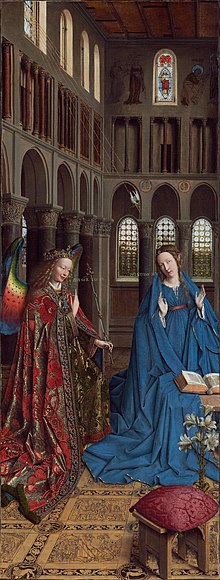| The Annunciation | |
|---|---|
 Annunciation, c. 1434–1436. Oil on Canvas, transferred from wood to canvas, National Gallery of Art, Washington D.C. | |
| Artist | Jan van Eyck |
| Year | 1434-1436 |
| Medium | Oil on Canvas |
| Dimensions | 90.2 cm × 34.1 cm (35.5 in × 13.4 in) |
| Location | National Gallery of Art, Washington DC, United States |
The Annunciation is an oil painting by the Early Netherlandish master Jan van Eyck, from around 1434–1436. The panel is housed in the National Gallery of Art in Washington, D.C. It was originally on panel but has been transferred to canvas. It is thought that it was the left (inner) wing of a triptych; there has been no sighting of the other wings since before 1817. The Annunciation is a highly complex work whose iconography is still debated by art historians. It was bought by the Tsar of Russia for the Hermitage Museum, but was sold by Stalin's government in 1930.
The picture depicts the Annunciation by the Archangel Gabriel to the Virgin Mary that she will bear the son of God (Luke 1:26–38). The inscription shows his words: AVE GRA PLENA ('Hail, full of grace...').[1] She modestly draws back and responds, ECCE ANCILLA D[OMI]NI ('Behold the handmaiden of the Lord').[2] The words appear upside down because they are directed to God and are therefore inscribed with a God's-eye view. The seven gifts of the Holy Spirit descend to her on seven rays of light from the upper window to the left, with the dove symbolizing the Holy Spirit following the same path; "[t]his is the moment God's plan for salvation is set in motion. Through Christ's human incarnation the old era of the Law is transformed into a new era of Grace".[3]
- ^ Contracted from 28 "et ingressus angelus ad eam dixit ave gratia plena Dominus tecum benedicta tu in mulieribus ..." – Latin Vulgate; 28 "And the angel came in unto her, and said, Hail, thou that art highly favoured, the Lord is with thee: blessed art thou among women." Authorised Version. King James (Authorised) Version
- ^ Contracted from 38 "dixit autem Maria ecce ancilla Domini fiat mihi secundum verbum tuum et discessit ab illa angelus" Latin Vulgate; 38 "And Mary said, Behold the handmaid of the Lord; be it unto me according to thy word. And the angel departed from her." King James/Authorised Version.
- ^ "Jan van Eyck, Netherlandish, c. 1390 – 1441, The Annunciation, c. 1434/1436". National Gallery of Art.